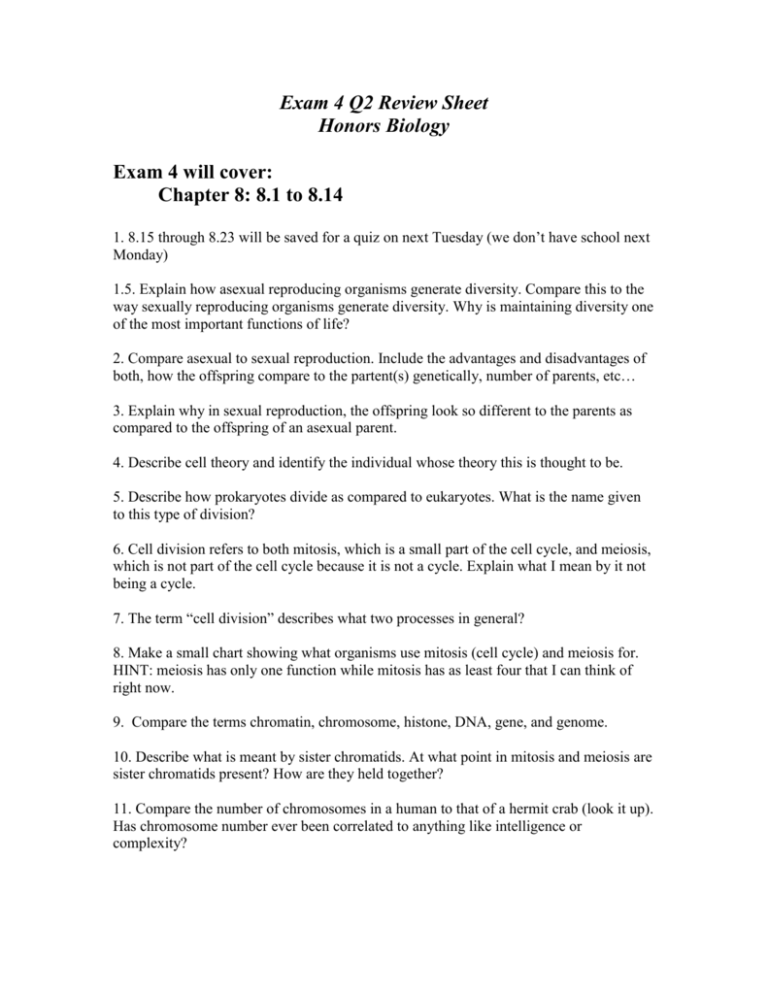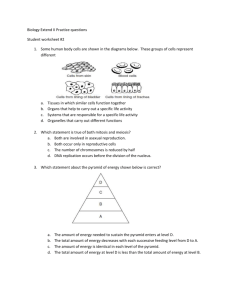Exam 1 Q2 Review Sheet - Great Neck Public Schools
advertisement

Exam 4 Q2 Review Sheet Honors Biology Exam 4 will cover: Chapter 8: 8.1 to 8.14 1. 8.15 through 8.23 will be saved for a quiz on next Tuesday (we don’t have school next Monday) 1.5. Explain how asexual reproducing organisms generate diversity. Compare this to the way sexually reproducing organisms generate diversity. Why is maintaining diversity one of the most important functions of life? 2. Compare asexual to sexual reproduction. Include the advantages and disadvantages of both, how the offspring compare to the partent(s) genetically, number of parents, etc… 3. Explain why in sexual reproduction, the offspring look so different to the parents as compared to the offspring of an asexual parent. 4. Describe cell theory and identify the individual whose theory this is thought to be. 5. Describe how prokaryotes divide as compared to eukaryotes. What is the name given to this type of division? 6. Cell division refers to both mitosis, which is a small part of the cell cycle, and meiosis, which is not part of the cell cycle because it is not a cycle. Explain what I mean by it not being a cycle. 7. The term “cell division” describes what two processes in general? 8. Make a small chart showing what organisms use mitosis (cell cycle) and meiosis for. HINT: meiosis has only one function while mitosis has as least four that I can think of right now. 9. Compare the terms chromatin, chromosome, histone, DNA, gene, and genome. 10. Describe what is meant by sister chromatids. At what point in mitosis and meiosis are sister chromatids present? How are they held together? 11. Compare the number of chromosomes in a human to that of a hermit crab (look it up). Has chromosome number ever been correlated to anything like intelligence or complexity? 12. Describe in detail the cell cycle (Fig. 8.5 should be in your head). Include interphase (G1, S, G2) and the mitotic phase (mitosis [PMAT] and cytokinesis). This should be obvious by now that mitosis is the same as meiosis II except for ________________. 13. How is mitosis different from cytokinesis? 14. Page 132…mitosis…know it , draw it, love it 15. Cytokinesis is different in plant and animal cells. Explain how they are different and why they need to be different. What is involved in or order to perform each. 16. Explain how anchorage, cell density and growth factor affect cell division. 17. How come growth factor, when added to a layer of cells, causes them to get smaller in size and larger in number, but the cells don’t grow on top of each other. 18. Compare anchorage dependence to density-dependent inhibition. 19. Explain how growth factors, which are typically proteins, can talk to the cell and trigger bypass of the G1 checkpoint. 20. How is the signal trasnduction pathway, initiated by growth factors, related to cancer. 21. What type of feedback is exhibited in the growth factor signal transduction pathway. Explain why you think so. 22. The cell cycle control system involved three checkpoint. Identify the three, and say whether the signal required to pass the checkpoint is external, internal or both. Give a logical reason for each. What is the cell looking for at each point? 23. In class we said that crossing the G1 checkpoint is the “point of no return”. What does this mean and what would happen to a cell if something went wrong in S phase and the damage to the DNA was unrepairable? 25. What is cancer? Identify the three characteristics of cancer. Why is it deadly? 25. Expain how cancer is related to growth factor and the G1 check point. How is cancer caused initially? 26. Compare and contrast a benign to a malignant tumor. 27. Compare a carcinoma, sarcoma, leukemia and lympohoma to each other. 28. Identify the current methods of treatment for cancer. 29. In class we spoke about vinblastine and taxol. Where in the cell do these molecules do their job? Where do they come from? How does this relate to deforestation? 30. We also discussed fludarabine. What is it and how does it work? 31. If you wanted to attack cancer, what might you design a drug (molecule) to do? 32. Normal mammalian cells typically divide about 50 times in culture (in a dish) before dieing. How is this different from cancer cells in culture? 33. At this point it should be clear that humans have 46 chromosomes in every cell except the gametes. How are these chromosomes related to each other? HINT: homologous pairs 34. Compare the autosomes to the sex chromosomes. Which chromosomes pair is unique to females and which is unique to males? 35. If we have two of every chromosome, and each chromosome has 1000’s of genes, then we must have two of every gene except for males. Explain why males have almost two of every gene, but only have one of certain genes. 36. If a female has a gene that codes for a protein that causes a disease like hemophilia on her X-chromosome, but her other X-chromosome has the normal gene, she does not have hemophilia (the disease is recessive), but she carries the gene. This chromosome with the hemophilia gene could end up in the egg. If a sperm containing a Y-chromosome fertilizes the egg, will the resulting child have the disease? Explain. 37. Draw a picture of a sperm and egg, fertilization, zygote formation, and development into a human or any other animal. Indicate which cells are haploid and which are diploid. Also indicate where mitosis occurs and meiosis occurs. Which cells would be considered n and which 2n? Explain why. 38. Be able to draw cells or look at drawings of cells and determine their ploidy and haploid number (n). For example, if you draw a cell with three number one chromosomes, three number two’s, three number threes and three number four’s, the ploidy would be triploid and the haploid number would be n=4. You should be able to do this for any combination I give you. Remember, a deck of cards would have a haploid number of 52 because there are 52 different cards. This is one set so it is haploid. If you have two decks of cards together then they are diploid, but n is still 52. Three decks of cards is triploid and so on… 39. Xenopus laevis (South African clawed frog) has 36 chromosome per cell. How many would be in the sperm is produces? 40. You analyze an Arabidopsis thaliana (plant in the mustard family) cell (2n=10) (you should know that 2n=10 means it has 10 chromosomes) under a microscope going through meiosis. You notice that the cell has 5 chromosome pairs, each consisting of two sister chromatids. What possible substage (PI, MI, AI, TI, PII, MII, AII, TII) of meiosis is this cell in? 41. Make sure you identify the subphase of any cell I show you in mitosis. Check out DCE #3 on page 152. You should be able to identify. 42. I would go through all the problems in the book on page 152 and 153 that are relevant to the sections. 43. Where is meiosis (gametogenesis) happening in humans? 44. Compare the chromosome number in somatic cells to that of gametes. 45. Of course the “essay” question: Explain how gametes are made from a single cell (meiosis). Be as detailed as possible. A diagram must be drawn for each phase along with your explanation. Start with a single human cell in G1. (The following terms should be included: haploid, diploid, synapsis, tetrad, homologous chromosomes, crossing-over, centrosomes, mitotic spindle, kinetochores, motor proteins, centromere, microtubules, metaphase plate, sister chromatids, chiasma, recombinant chromosome, meiosis I and associated subphases, meiosis II and associated subphases, chromatin) I put some mitosis and meiosis videos up on the website under the misc. section.







